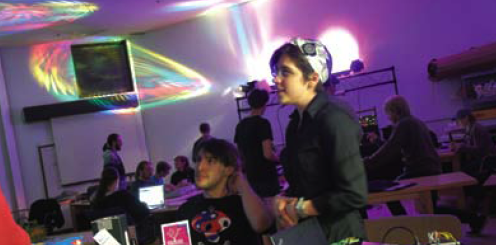From making envelopes to pushing the envelope
by Hartley Pleshaw
Artisan’s Asylum is located in the former factory of the Ames Envelope Company. Somerville is the home of a lot of places called “former factories.” Such is the reality of postindustrial America—particularly in the Northeast and the upper Midwest.But spend any time there now, and the observer would be well advised to drop the word “former.” 10 Tyler Street is a busy, productive place again, a place where people are doing things and making things. In one sense, it really is a factory again; in another, it can be called a vibrant artist’s colony.
Stroll around the Asylum, as many did during an Open House in December and befitting that particular time of year you’ll see something not unlike the workshop Santa Claus supposedly keeps humming all year round at the North Pole. And while you won’t meet any elves, you will meet people who are often engaged in making things that will make people very happy. Toys and games, yes, but also jewelry, visual arts, sculpture, clothes, robots and films.
Artisan’s Asylum describes itself as a “community workshop.” It offers work and storage space, opportunities to teach and to take classes, equipment to use and share (for people both in and outside the facility), and an overall community of work and sharing. In its present location (after outgrowing earlier ones), it occupies 40,000 square feet. Its membership runs to hundreds. Along with Santa’s Workshop, comparisons can be made to everything from the Plymouth and Jamestown colonies to the Shaker Villages to “starving artist” enclaves through the centuries to the hippie communes of the 1960’sand ‘70’s. But in its practical uses, it is totally relevant to the present day.
How It Happened, How It Works
Molly Rubenstein is the interim Executive Director of Artisan’s Asylum. She recalls how it all came together.

Daniel Sternof Beyer, public artist, is holding a wind light; it is just like a wind chime, but it emits light with LEDs powered by the rotating helix
“At the time, the place was being entirely run by volunteers. I had no professional draw to Boston; I was pursuing other things elsewhere, and wasn’t able to participate in the community—although I greatly admired what they were doing. (But) by now, March/April 2011, Gui told me that he was leaving his full-time job, to make the Asylum a real entity—one that was big enough to support its own staff.
“It took about two to three minutes into our phone conversation for me to decide that I was going to leave my job and join him.”

Aaron Falk, the chairman of the board of Artisan’s Asylum, on the drums and James Arthur, director of CEMI DJing in the back
engineering and building.
“(Gui) graduated from school, and started to work for a robotics company. He was expected to work on robotics during the day, then come home and do social things like go to movies, eat meals and read books. He was desperately missing that creative environment of being able to make things under his own control, not just make things that somebody else was asking for.
“His partner, Jen Martinez, was a costume designer; she was also looking for space. She was really interested in having her own space, a space to work in that wasn’t home.
“So, they came up with the idea to create a small space, which maybe they’d share with a few friends, who could share the cost of the factory equipment, which was relatively expensive. They collected $40,000 worth of investments
and put together a small shop with a mill, a lathe, some woodworking equipment and some sewing machines. They then sent out a message to all of their friends in the community. They thought that maybe twenty or thirty
people might show up. A hundred people showed up at the first meeting.”
community need.
According to Molly Rubenstein, “The vision began to shift from simply a place where they could make things with some other friends to a way that they could serve a community of makers that needed a space to gather.”
CEMI
Among those who have gathered at Artisan’s Asylum is the Collaborative Electronic Mixed Media Institute, a.k.a., CEMI. It describes itself as consisting of “artists, musicians, designers and engineers that create and enhance the electronic arts culture of Greater Boston.”
Among those people at CEMI is Kat Dobbins. “CEMI is many different things. We primarily offer classes in digital arts mediums. That includes lights. That includes literally anything you would need to put on an event.
Mihai Dinulescu is a founding member of CEMI. He’s also a filmmaker. “Film is the ultimate electronic mixed media. You have old-school analogue film. You’ve always got that mixture of music, and dance, and timing, and pacing, and lighting, and editing, and Foley, and sound design, and sound mixing. There are so many steps. And there are so many different fundamentally technical art forms.
“Anything we do can become a short film, because all we have to do is take a camera, and point and shoot. We have a video on You Tube now, of a guy who’s making music with his brain. He’s literally got an EEG on top of his head, and he is able to match beats, with fairly pleasant tones, to a DJ that’s playing in the same room.
“It’s when your life becomes a movie, whether it’s filmed or not. That is what I think makes CEMI special.
“We would definitely like to collaborate with other filmmakers. We’re set to collaborate with CHAINSAW MAIDENS FROM HELL (see IMAGINE October 2012), in
terms of getting some sound help, some mastering help.
“These are great people, in terms of anything relating to sound, music or visual effects, and it’s a fantastic wealth of resources. In terms of filming, when I first walked in here in November, and there was somewhat of a setup—this was a film studio.
“You’ve got casters. You’ve got metal workers. You’ve got engineers. You’ve got designers. You’ve got visual special effects people. You’ve got animators. You have every single part of filmmaking under one roof. I’ve found the hardest part of filmmaking is finding a crew. Who could ask for a
better crew, than the one you can find in this building?”
Matt Martino is another CEMI-associated filmmaker. In his planning for a future film, he is already factoring in the advantages of joining forces with Artisan’s Asylum.
“Our hope is that we can use Artisan’s Asylum as a way to add production value without also having to add a large bankroll to our next film. We’re making a very low-budget movie, but we want as much money to appear on the
screen as we possibly can. So, we want to be able to use the resources of Artisan’s Asylum, like the shared co-working space, as well as a lot of the people there, in order to make some really cool and unique things.
“For example, I was speaking with a props maker. She does casting and molding. So, we may have her make some custom props for us. She can even teach a class; she teaches a class called ‘Prop Making for Movies.’ So, (from) this class, we might have a bunch of people come in, and make props
for our movie. She’ll get paid as an instructor, while her students make props for the movie.
“So, we get to have some custom-made, one-of-a-kind pieces of art that are used in our movie that absolutely no one else could possibly have. And, we get to get it at a very low price.
“I’d rather support young artists, up-and-coming artists who really want to work, than try to go after established people who are already working, and for whom this is just another job.”
In fact, Matt Martino finds Artisan’s Asylum comparable to a large film studio. “(It) has a lot of spaces that large studios would have. It has a woodworking shop, where we can build custom set pieces; it has costume making facilities, where we can make our own custom costumes; but it also hasthe people who work in them, and teach classes.Classes on how to build a set, how to make costumes, how to make props and so forth. A paint shop and a woodworking shop—those are all nice things to have. To rent out a studio to do these things would be considerably more expensive. You’d have to rent the time and hire workers. (Here), we can do it in an educational manner, where we have the facilities at our disposal.”
“The important thing is that we could probably get Hollywood production values for a fraction of the cost. As an independent filmmaker, that’s key. We want to make this movie look like a million dollars, even if we don’t have a million dollars.”
Dollars. The most essential filmmaking tools and the ones that just get harder and harder to come by. And not just for filmmakers, either. Artists of all sorts have found it tough in the new millennium. The declining economy finds film studios, television networks and stations and grant-giving foundations and individuals far less generous than they once were. In their struggles to both realize their possibilities and visions as artists, and to make a living, Molly Rubenstein sees the old envelope factory at 10 Tyler Street in Somerville as indeed offering asylum to creative people.
“Artists are trying to find ways to create solvent businesses, doing the art that they find meaningful.
“There isn’t the money these days from government, or even from individuals who subsidize art with a capital ‘A’. Artists are trying to find ways to do it themselves. It’s a pretty incredible evolution that’s happening.”
For more information visit ArtisansAsylum.com or email info@ArtisansAsylum.com.
Hartley Pleshaw has written for IMAGINE for the past six
and a half years. He has worked in Boston-area television, radio,
film, video, theater and journalism for the past three decades.
His email address is hartleypleshaw@gmail.com.







